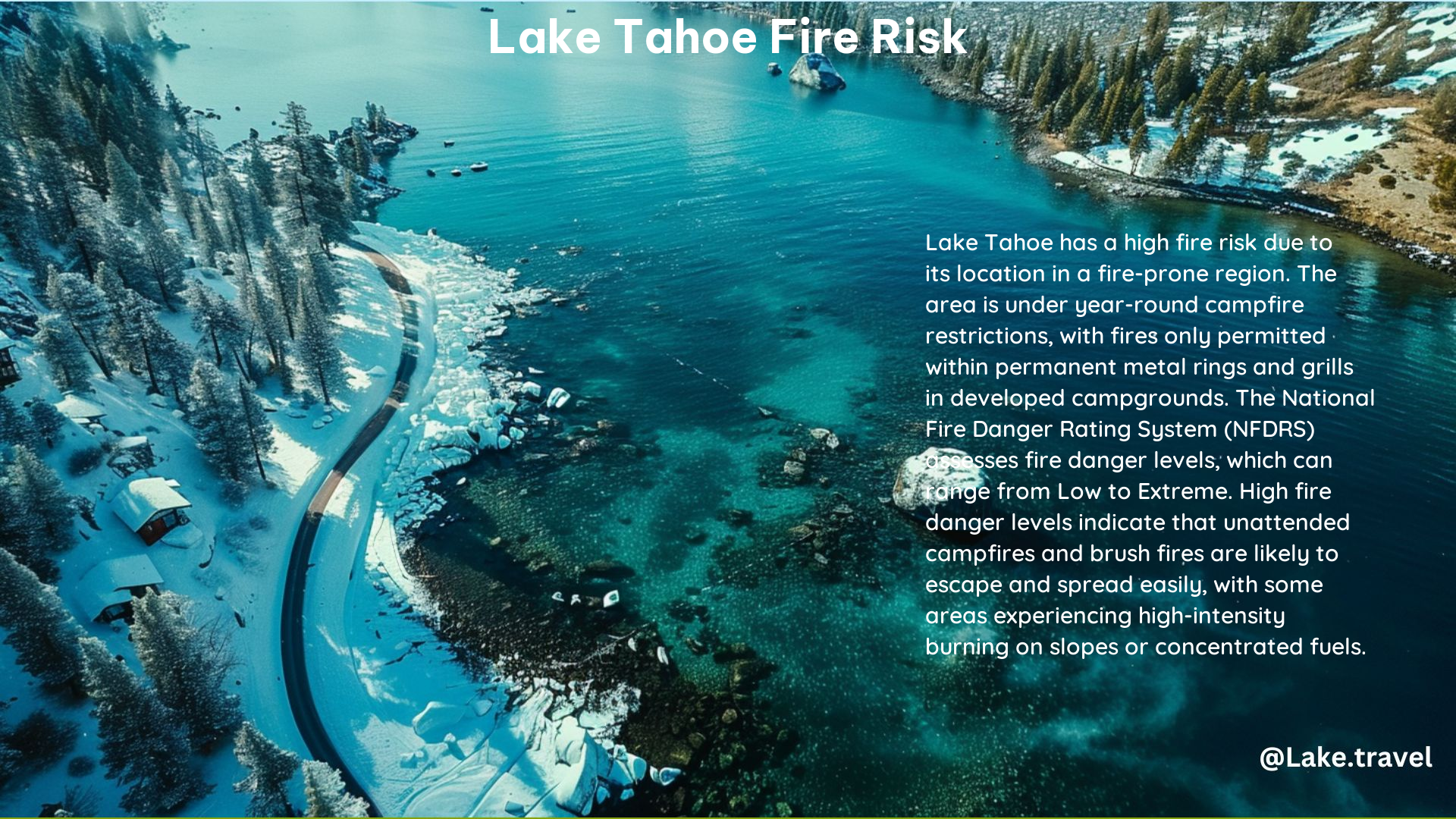Lake Tahoe, a breathtaking natural wonder nestled in the Sierra Nevada mountains, is also a region with a high risk of wildfires. As a lakes touring enthusiast, it’s crucial to understand the fire danger in this area and take the necessary precautions to ensure a safe and enjoyable experience.
Understanding the Fire Danger Rating System
The National Fire Danger Rating System (NFDRS) is the primary tool used to assess the fire risk in the Lake Tahoe region. This system combines various factors, including fuels, weather, topography, and risks, to provide a qualitative or numeric index that reflects the area’s fire protection needs. The NFDRS has five color-coded levels:
- Low: Fires are unlikely to start, and if they do, they will spread slowly.
- Moderate: Fires can start from accidental causes, but the number of starts is low. Fires will spread quickly on windy days.
- High: Fires can start easily from most causes, and small fuels will ignite readily. Unattended campfires and brush fires are likely to escape.
- Very High: Fires will start easily and spread rapidly, with a quick increase in intensity.
- Extreme: Fires of all types start quickly and burn intensely, with long-distance spotting likely.
Minimizing Wildfire Risk in Lake Tahoe

To reduce the risk of wildfires in the Lake Tahoe region, it’s essential to take the following precautions:
- Campfire Safety: Ensure that campfires are fully extinguished before leaving them unattended. Use metal fire rings and have a bucket of water and a shovel nearby.
- Fire Restrictions: National Forest lands in the Lake Tahoe Basin are under year-round fire restrictions. Fires are only permitted within permanent metal rings and grills in developed campgrounds.
- Prescribed Burns: Prescribed fires are used to remove fuels that can feed unwanted wildland fires, improving forest health and reducing the risk of catastrophic fires.
- Defensible Space: Maintain a safe area around homes and infrastructure by removing flammable materials and creating a fire-resistant zone.
Impact on the Local Housing Market
The wildfire risk in Lake Tahoe has a significant impact on the local housing market:
- Fire Insurance Costs: Fire insurance costs are a major concern for homeowners, as the risk of wildfires increases insurance premiums.
- Housing Affordability: The high cost of housing in Lake Tahoe, combined with the risk of wildfires, makes it difficult for locals to afford homes, leading to concerns about being priced out of the market.
- Fire Risk and Property Values: Properties in high-risk areas may see a decrease in value due to the increased risk of wildfires, affecting the overall housing market.
Additional Considerations
- Evacuation Planning: Familiarize yourself with the local evacuation routes and have a plan in place in case of a wildfire emergency.
- Monitoring Fire Danger: Stay informed about the current fire danger level by checking the NFDRS ratings and any fire restrictions or warnings in the area.
- Reporting Suspicious Activity: If you notice any suspicious activity or potential fire hazards, report them to the appropriate authorities immediately.
As a lakes touring enthusiast, it’s crucial to be aware of the fire risk in the Lake Tahoe region and take the necessary precautions to ensure a safe and enjoyable experience. By understanding the fire danger rating system, following fire safety guidelines, and staying informed about the local housing market, you can help protect this scenic wonderland from the devastating effects of wildfires.
References:
- City of South Lake Tahoe. (n.d.). Fire Danger/Red Flag Warning System. Retrieved from https://cityofslt.us/1094/Fire-DangerRed-Flag-Warning-System
- Reddit. (2023). I’ve got a strange question. Retrieved from https://www.reddit.com/r/tahoe/comments/16bieff/ive_got_a_strange_question/
- USDA Forest Service. (n.d.). National Fire Danger Rating System and Red Flag Warnings. Retrieved from https://www.fs.usda.gov/detail/ltbmu/fire/
- USDA Forest Service. (n.d.). Campfire Restrictions at Lake Tahoe. Retrieved from https://www.fs.usda.gov/detail/ltbmu/home/
- RiskFactor. (n.d.). South Lake Tahoe, CA Wildfire Map and Climate Risk Report. Retrieved from https://riskfactor.com/city/South%20Lake%20Tahoe-California/673108_fsid/fire
